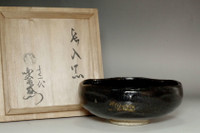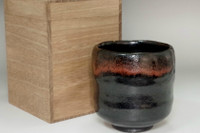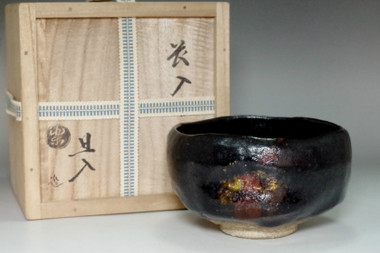 Loading... Please wait...
Loading... Please wait...Currency Displayed in
- Home
- SOLD ITEMS
- ★7th Chonyu (1714-1770) Antique kuro-raku tea bowl #4314
Categories
★7th Chonyu (1714-1770) Antique kuro-raku tea bowl #4314 for sale
Product Description
Up for sale is this "★7th Chonyu (1714-1770) Antique kuro-raku tea bowl #4314" If you have any questions please contact us before buy it. No reserve.
- width: approx. 10.8cm (4 1⁄4in)
- height: approx. 7cm (2 3⁄4in)
- weight: 272g (gross 586g)
- comdition: hair line crack, small crack
Born as the eldest son of the 6th generation Sanyu, he took over as the head of the family and didn’t retire until age 49, later passing away at age 57. Since taking on this new role, he worked tirelessly making pottery and ceramics for 40 years. His original name was Sokichi, and he was later renamed Eisei.
After Chojiro started on the Raku tea bowls, they were followed up by potters Jokei and Donyu to give them a more modern decorative effect, changing them quite drastically. During the era of Ichiiri and Sonyu, there was a return to to the Chojiro tea bowl, a work by tea master Rikyu. Shortly after, this bowl gets passed on to Chonyu, who was active during the middle of the Edo period, via Sanyu, who was able to freely use the concept of moldability in his work.
During the tenure of Chonyu, the Senke family, which began from the Rikyu line, split into 3 separate families and began to flourish, establishing themselves into the Iemoto family system, and spreading the tea ceremony to the townspeople like never before. The middle Edo period displayed a stable and matured cultural foundation, in which Chonyu could enjoy a long 40-year career of pottery, deepening his cultural exchanges with Iemoto and tea masters, such as Joshinsai Sousa, Ittou Soushitsu, Jikisai Soushu, and Kawakami Fuhaku. Chonyu could apply a traditional Raku style to his own tea bowls, fully expressing this time period in his work, and exhibiting the tendency toward a formalized bowl shape. It was around this time that the mouth of the tea bowls started to undulate like a mountain, and this gave rise for the opportunity to develop this feature into a formalized style referred to as the “Gogaku”, the generic term for a series of five mountains. Needless to say, there is no style called the “Gogaku” within the Chojiro style of tea bowls, and the formalization within these traditional styles has been fixed within the tea ceremony society since the end of the Edo period. This type of fixation has nothing to do with the underlying spirit of the Raku tea bowls.
The appeal of Chonyu’s pottery is not in its formalized style, but in its large size, its slightly thicker structure, and its solid, bold presence. Chonyu’s style of tea bowls do not have the strong individual style like his father Sanyu’s did, but it seems Chonyu’s gentle style is a reflection of Nagairi’s own good personality along with the stable social climate of the middle Edo period. Like his father, Chonyu also occasionally used the spatula to garnish his works with some decoration. A glossy black was the preferred color of glaze for the tea bowls, and the black tone is similar to that of black lacquer. The red glaze has several different color varieties, ranging from a very light to very deep. Furthermore, the sculptures and figures on the incense container and the Raku family Buddhist altar, represented by the “Statue of Saint Nichiren”, exhibit the finesse of special precision engraving, said to be a unique characteristic of Nagairi’s work.
The Omotesenke 7th generation Joshinsai enjoyed the Tamanoe (lit. “ball drawing”) decoration on tea bowls, and created many works that exhibit such design, for example, the “Fukurokuju” black Tamanoe cylindrical Raku tea bowl, the Takenoe black Raku tea bowl, the red Raku tea bowl, the God of Longevity (Juroujin) red Raku tea bowl (of the Fushin’An Tearoom in the Omotesenke Iemoto Grounds, Kyoto Prefecture), as well as the green glazed elephant incense holder, the Statue of Saint Nichiren, and the Zushi; a small cabinet with double doors used by the nobility to store books and other important Buddhist sutras.
shop policy
AppraisalWe appraise our items using various resources. If you feel that a purchased item differs from your expectations, please inform us. We respect your opinion.
Cancellation and Return
We accept return only if you contact us within 30 days after you receive the items. Return-shipping costs are the buyer’s responsibility. If you ask a cancellation before shipping the package, we may ask a 20% restocking fee.
Shipping
+ Shipping to the USA, Europe, and Asia is free. For other areas, please contact us. Shipping is via EMS or DHL.
+ VAT is not included in the item price.
+ We will ship within 3 business days. Shipping time is usually around a week.
Insurance
We are not responsible for delays, returns, damage or loss due to customs or postal processing. EMS is insured (the amount on the label is the guaranteed amount). If you choose DHL, we recommend that you purchase additional insurance. Please note that if you choose the DHL drop service option, insurance will not be applied.
Taxes
Import duties, taxes and fees are not included in the item price. If your country requires customs duties, etc., it is your responsibility to pay them.
To customers buying tableware
Our products are mostly used. We sell them in the same condition they were purchased, please be sure to clean them thoroughly before actually using them.




















